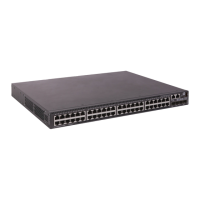92
Managing configuration files
Overview
A configuration file saves a set of commands for configuring software features on the device. You can
save any configuration to a configuration file so they can survive a reboot. You can also back up
configuration files to a host for future use.
You can use the CLI or the Boot menu to manage configuration files. This chapter explains how to
manage configuration files from the CLI.
Configuration types
The configuration loaded at startup is called "startup configuration" and the configuration that is running
on the device is called "running configuration."
Startup configuration
The device uses startup configuration to configure software features during startup.
The following are sources of startup configuration:
• Initial settings—Initial values or states for parameters. If the device starts up with empty
configuration, all parameters use their initial settings at startup.
• Default configuration file—Contains factory defaults, which are product-specific default settings
that are different from initial settings. The file is included in the .ipe software image file. If you do not
configure the device to start up with empty configuration or a startup configuration file, the device
loads the default configuration file to configure features at startup. If a parameter is not included in
the file, the device uses its initial settings.
• Startup configuration file—Configuration file you specify in the Boot menu or CLI for startup. The file
is called the "next-startup configuration file." After the file is loaded at startup, it is also called the
"current startup configuration file." For high availability, you can specify two next-startup
configuration files, one main and one backup (see "Specifying a next-startup configuration file")
.
No commands are available to display the initial settings. For more information about these settings, see
the "Default" sections in the command references.
To display the product-specific default settings, use the display default-configuration command.
To display the current startup configuration file and the next-startup configuration files, use the display
startup command.
To display the contents of the configuration file for the next system startup, use the display
saved-configuration command. This command does not display settings that have not been saved to the
configuration file.
Running configuration
The running configuration includes unchanged startup settings and new settings. The running
configuration is stored in the memory and is cleared at a device reboot or power off. To use the running
configuration after a power cycling or reboot, save it to a configuration file.

